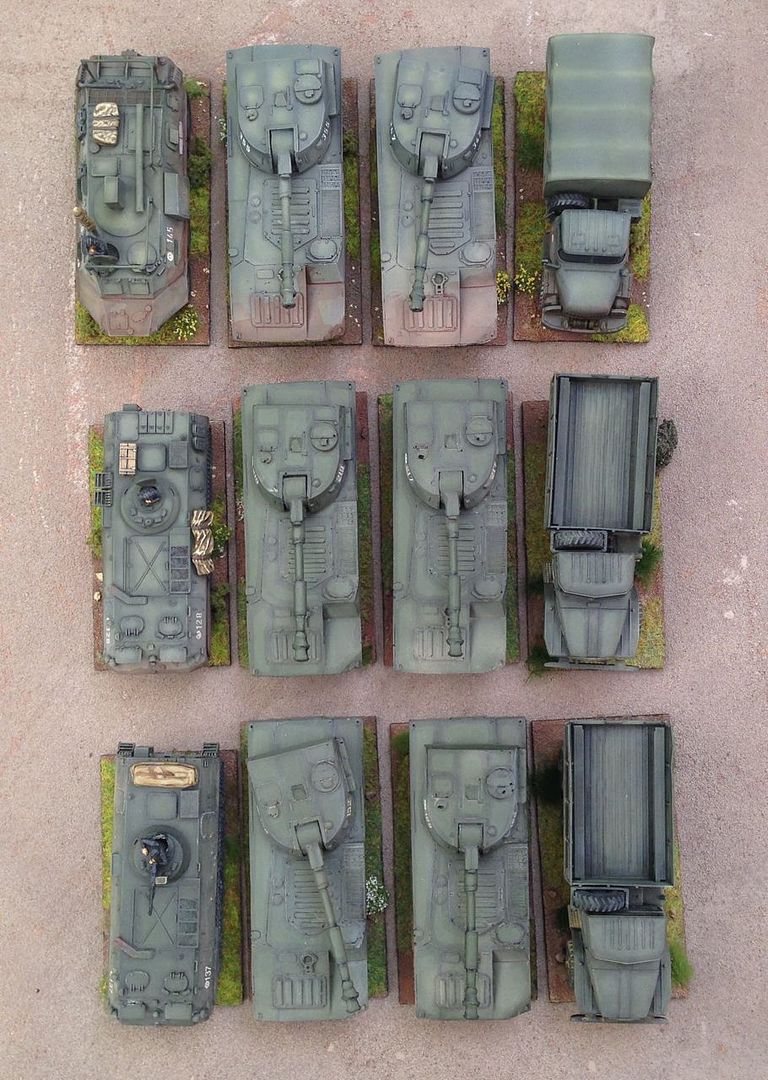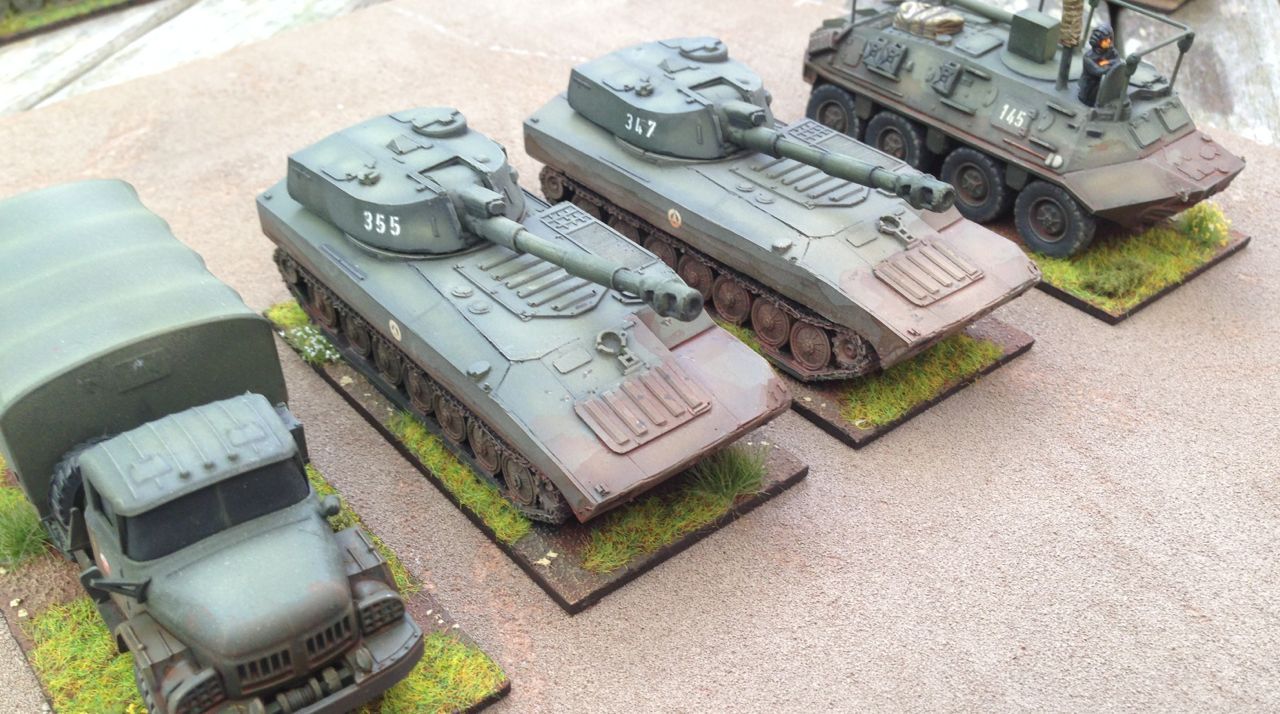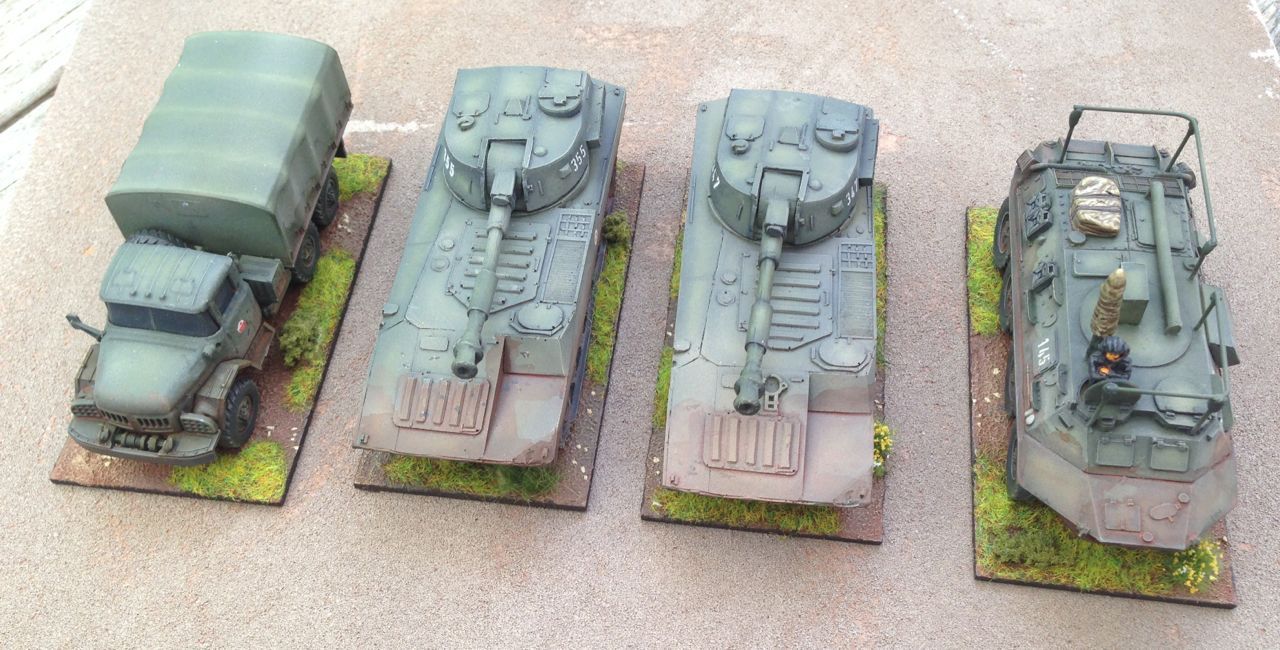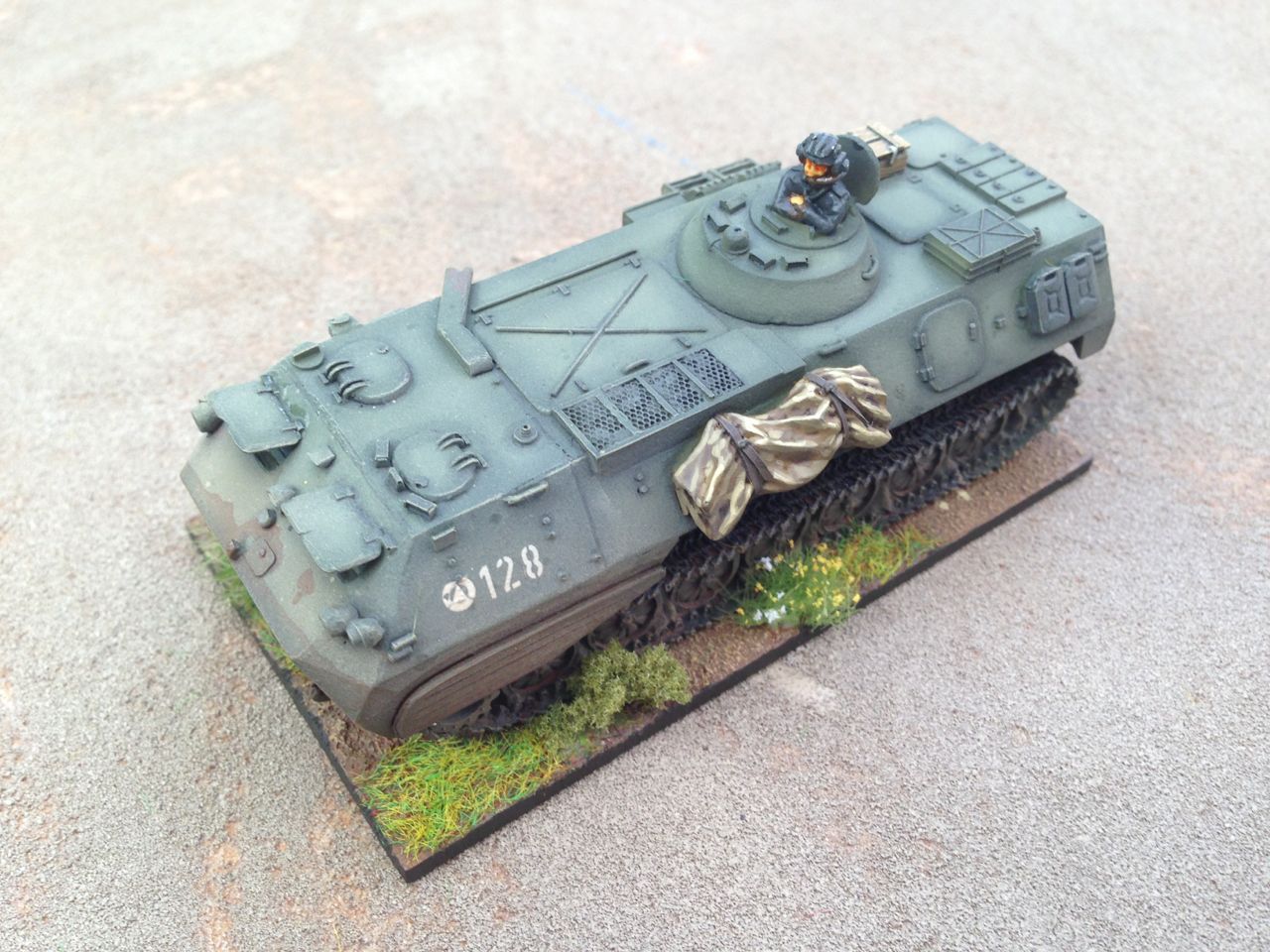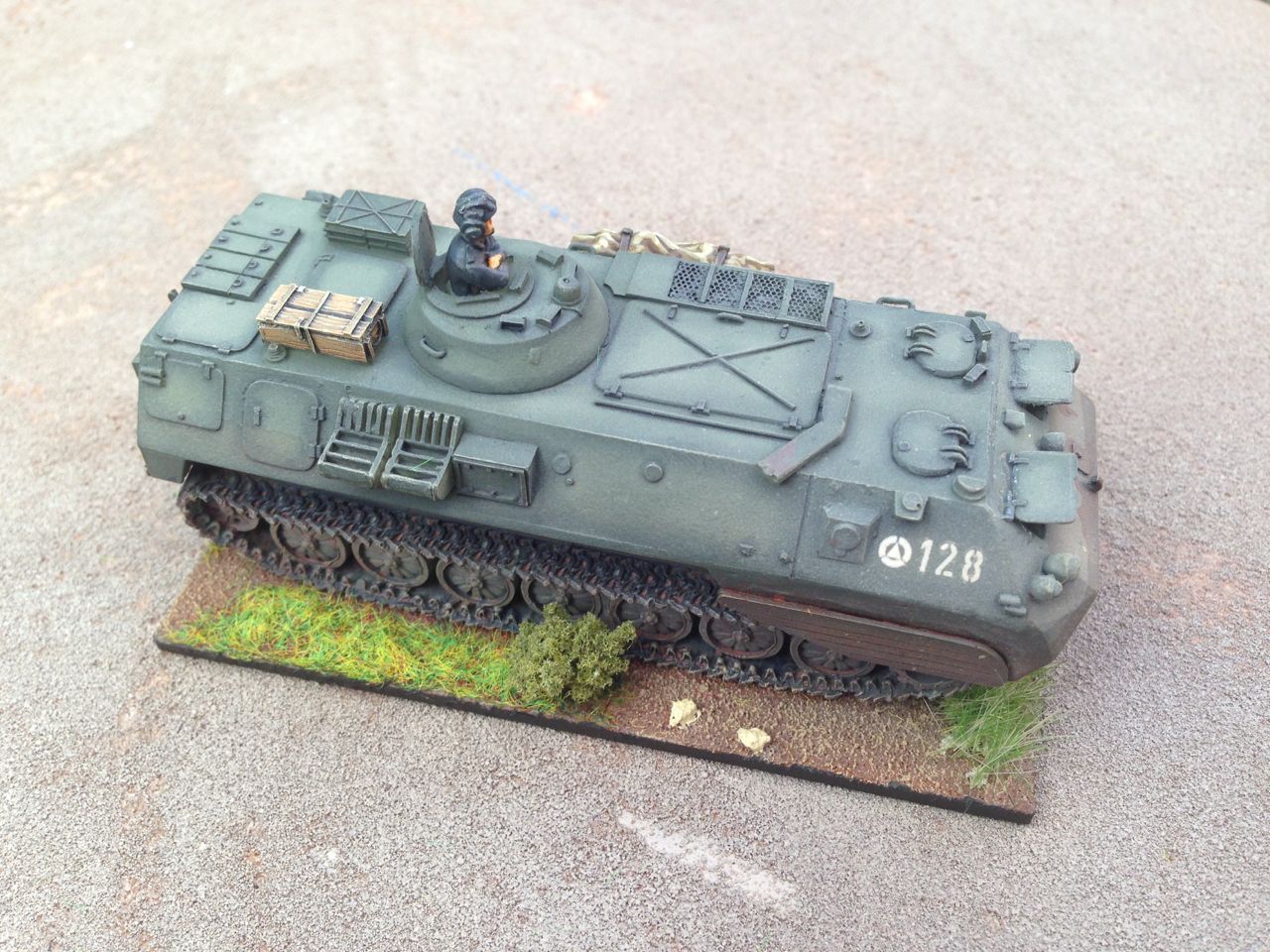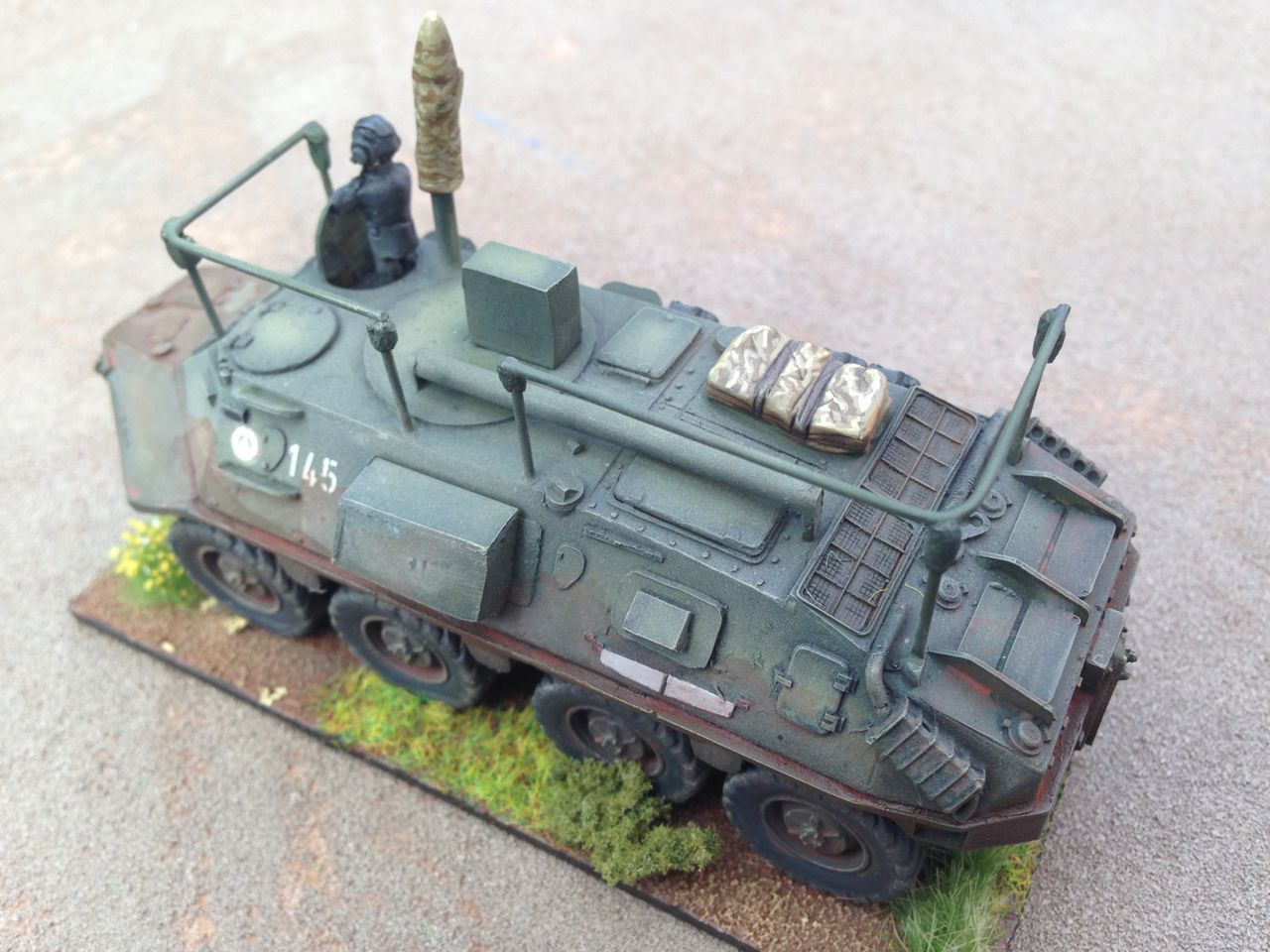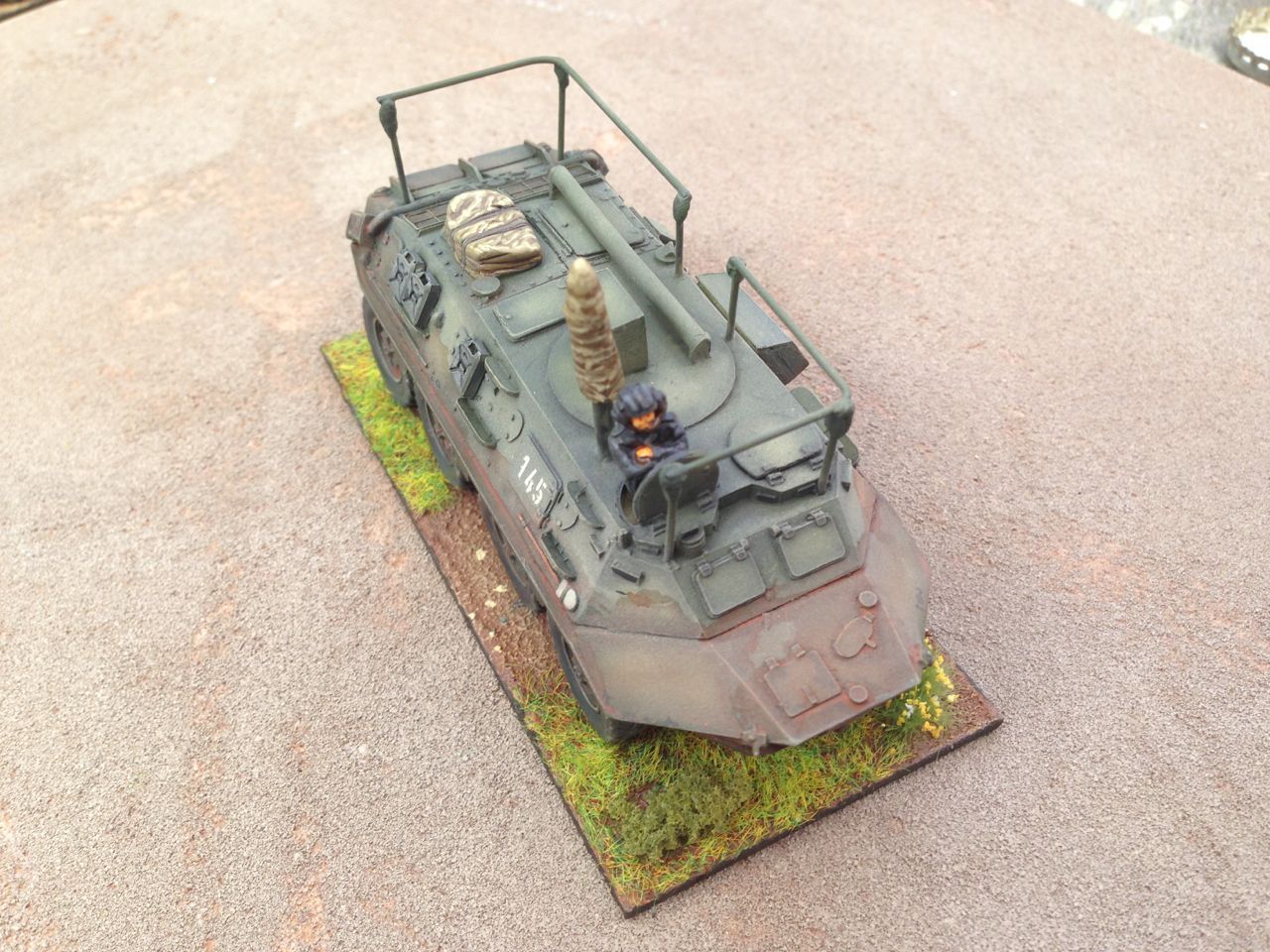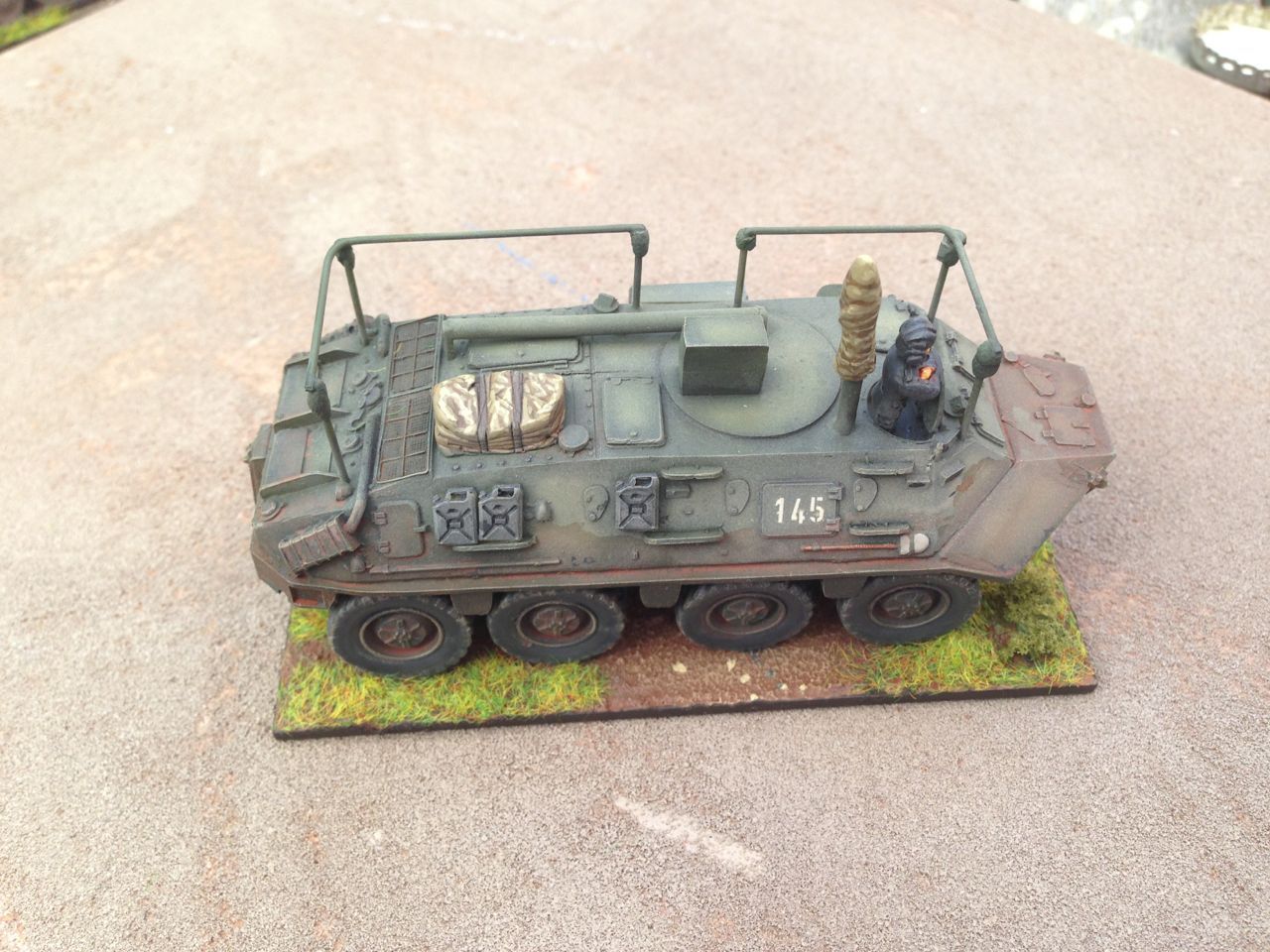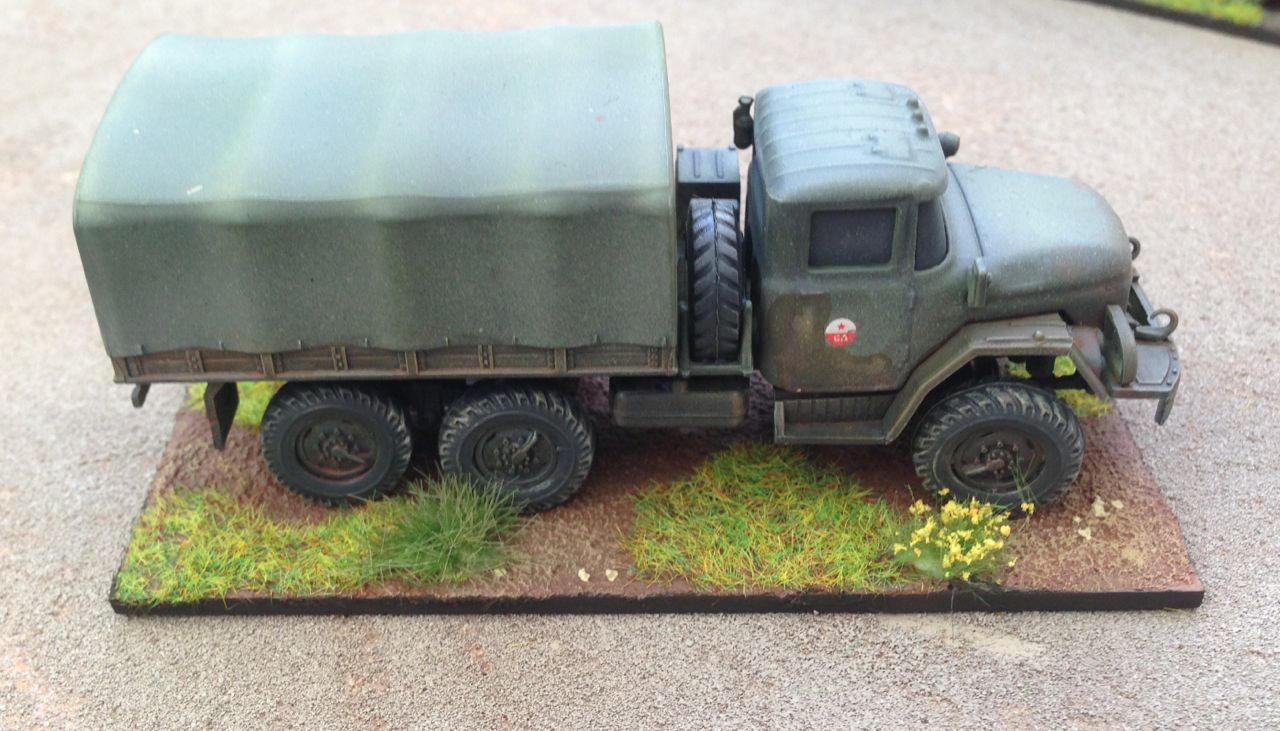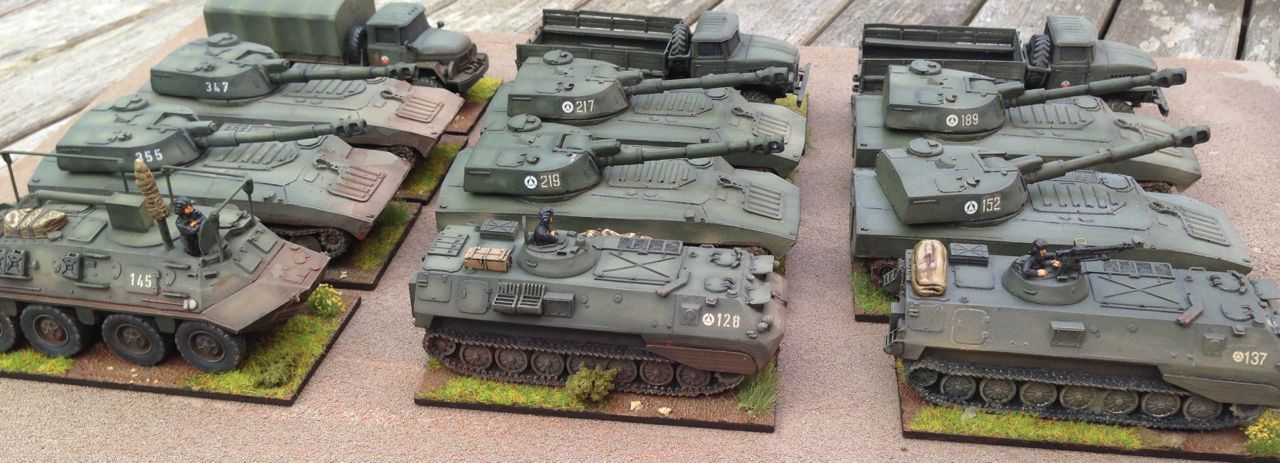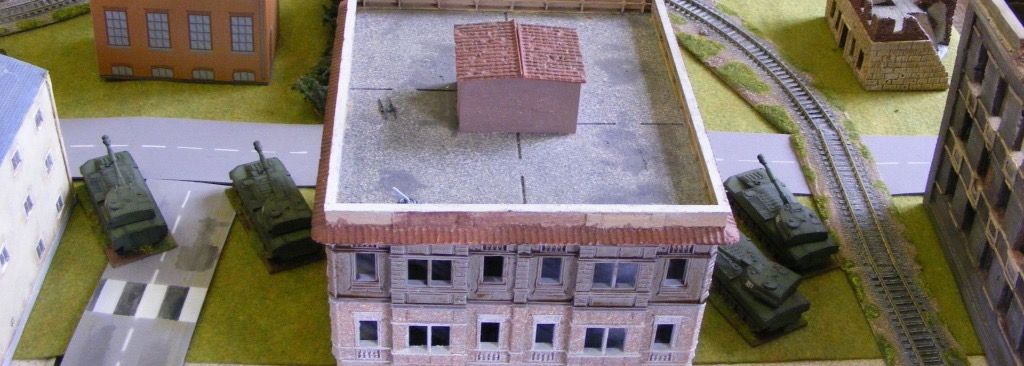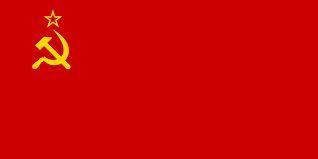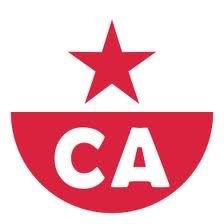
The Soviet Army had well developed
doctrine around march security and transition to battle formations from the line of march, this was critical to acheiving success in the encounter battles they postulated would be the most common form of engagement and in maintaining the rates of advance they envisioned. This is an area where a degree of task organisation would occur and provides a good framework for Scenario development for smaller games. The Advance guard is well documented across a variety of sources so it is straight forward to research, FM 100-2-1 is one of the best.

As an added bonus the Advanced Guard is a small self contained force that makes an excellent choice for a starter army. So an interesting vehicle for exploration of the organisation and processes associated with its operation. Its part of what most people would consider the classic Soviet steam roller and these elements rarely appeal to me, but for the reasons stated above and some interesting time and space problems associated with the relationship between the advanced guard and the main body that I think are less well understood its worth looking at.

The Advanced Guard mission was to provide forward march security to the lead Regiment on an axis of advance, in the example we will look at here we will consider a MRR but a TR could equally be configured to fill this role. Unlike the Forward detachment the purpose was to provide warning and an initial raction force to deal with enemy encountered on route as the MRR moved down its axis of advance. The Advanced Guard was a key component in transitioning the Regiment effectivly from March Formation to Battle Formation. In contrast the
forward detachment was tasked with specific missions to take and hold terrain constraints or block reserves, the unifying purpose of both organisations however was the same, in order to allow the MRR/MRD to advance along the line of march at speed.
March formations in the British army were used for out of contact manouver, where contact was expected then the unit would be configured to advance to contact, a battle formation for which the manouver speed would be much lower as this was a tacticle deployment. Reacting to contact from a march formation would be an emergency procedure and certainly in my experience was seldom discused or practiced, advance to contact was, so the British and Soviet doctrine is very different.
The MRB would be reinforced and task organised to acheive its mission the level of reinforcement would be dependent on a number of factors:
- Weather the Regiment was on a main or subsiduary access
- The type of offensive action being prosecuted
- March
- Pursuit
- Meeting Engagement
- Enemy Posture and Strength

The Soviets adapted 2 Pre battle formations based on whether they expected to encounter the enemy or not. If encounter with the enemy was expected then march security elements would be deployed to front, flanks and rear of the main body. The Advanced Guard would deploy in three components on a single axis. These were:
- The Combat Recce patrol of a platoon of Infantry and a single tank
- The Advance Party, the remainder of the lead Company reinforced by a range of assets depending on the situation and what had been provided to the Advanced Guard these could include:
- Morter Platoon, Morter Battery or Gun Battery, 120mm Mortar or 2S1
- AT Section or Platoon, BRDM2 +AT5
- Engineer Section
- Tank Platoon, depending on formation T-64, T-72, T-80 marks being dependent on year.
- The Advance Guard Main Body, the remainder of the lead Motor Rifle Battalion and the remainder of the reinforcement units that could include:
- Air Defence Platoon, ZSU 23-4 or SA-9 or 2S6 or BMP2 + SA14
- Battery or Battalion of Guns, 2S1 or 2S3
- Up to an AT Company,
- Engineer Assets, relevant to the opperation

The Advance Guard could operate in close co-operation with a number of regimental assets which for scenarios involving the advanced guard could easily be included, these are:
- The reinforced regimental Recce Company, reinforcement would come from engineer, chemical and artillery reconaisance assets
- The Mobility Support Group which would be a task organised engineer group reinforced with infantry and armour from second echelon formations, with the primary role of clearing and breaching obsticles identified by the reconaisance elements.
- Regimental Artillery Group, assets in range would provide supporting fires as directed by the Regimental commander in the event of contact. Command and Observation Posts might be grouped with the components of the guard to provide coverage
- Regimental Headquaters, frequently the Regimental HQ might travel with or just to the rear of the Advanced Guard, equally the Battalion HQ might travel just to the rear of the Advance Party, I have not represented this in the force as presented here
Additionally interesting scenarios might be constructed around interaction with in place elements such as forward detachments. Passage of echelons might also be worthy of consideration although weather this would be done in march formation might be subject to situation and the proximety of remaining enemy.
Bearing in mind that I play based on Rapid fire the abstraction of the vehicles and personel used by this ruleset presents a number of challenges in representing these elements. Looking at it from front to back I have currently decided to represent the Advanced Guard and the associated regimental elements as follows:
Reinforced Regimental Recce Company
The purpose of the Regimental Recce Company was to gather intelligence and develop the information identified by other forward deployed asset such as the Divisional Recc battalion, it was not part of the Advanced Guard, it was key to identifying enemy and targets and can work well as part of a depth game.
I currently represent the regimental
Recce Company with a
BMP R as the HQ and a BRDM2 and a BMP platoon each represented by a vehicle. The organisation included a motorcycle section which is currently un represented. Reinforcement comes in the form of a single
BRDM2 Rkh platoon from the Regimental Chemical defence Company, and assets from the
Divisional Engineer recce elements in BTR 60 and a
PRP 3 representing artillery reconnaissance elements from a reinforced RAG. I intend to operate these as three pairs each with a BMP and BRDM2/BTR60 in it.
The Advance Party.
The advanced party provided march security for the advanced guard and was in turn protected by a combat recce patrol that it would deploy forward. Depending on circumstances terrain and visibility it could work closely with the CRP providing support and overwatch, or stand off from the CRP to give greater reaction time. Distances between the two elements are quoted as between 1.5km and 5km depending on sources. On Contact the advanced party could block, strike or maneuver and strike depending on the size and disposition of the encountered force. The effects of these actions would be to fix or destroy the opposing forces lead elements.
The representation of the CRP is quite difficult given the Rapid fire approach to one APC to each company. Because the BMPs are very under represented my personal preference here is to add an additional BMP effectively with no dismounts, as a Recce element. Where CRPs are required to provide flank guards the same approach would be taken.

The remainder of the Advance Party includes;
- A Tank platoon, represented by a single tank,
- A MR Coy represented by a BMP 2 and the associated dismounts.
- An ACRV Command and Observation Post(COP) from the battery or battalion attached to the parent MRB.
- The MRBs Mortar Battery, represented by 2 MTLB and 2 120mm Mortar. These might also be grouped with the Advanced Guard Main Body.
The COP would be using the unit as protection and would be available to adjust fire to achieve the requested effect, if fires were allocated by the Combined Arms Commander at Battalion or Regimental level. This is somewhat different to western use of Observation Officers. If more artilery had been attached to the Advanced Guard this could equally be a Battery of 2S1. If deployed these might be used in a direct or indirect fire role.
Additional elements that could be represented include the Advanced Guard battalion commander who would move forward if contact was expected an AT Section or platoon and engineer elements. If your just starting out in Cold War this sort of force provides a great starter option with both vehicle variety and small size yet capable of realistic deployment in a number of scenarios,

The Advanced Guard Main Body.
The Advanced Guard Main Body is constituted from the remainder of the Advanced Guard and it provides march security for the lead regiment. Depending on circumstances distance between it and the advance party could be between 1.5km - 10km this seems to be dependent on whether the advanced party is supporting the CRP or stood off from it as the distance to the CRP seems to be a fairly consitant at 10km.
On contact it could block or strike and if striking would be highly likely to maneuver and strike in order to take an enemy in the flank. The purpose would be to destroy the lead enemy company and fix or destroy the lead enemy battle group.
The Advanced Guard MRB has been reinforced with a battery of guns, one AA Platoon from the regimental Air Defence Platoon, and a Platoon from the Regimental Anti Tank Company. It is missing those elements already detached to form the Advanced Party. The Battalion commander has grouped his own Air Defence Platoon with the ZSU 23-4 platoon.
and the Tank Company Headquaters tank has been grouped with the AT - Platoon to form a small
Anti Tank reserve. This element would be used to counter unexpected enemy tank action, or screen open flanks. I am not convinced it would be formally committed as part of the immediate plan as that would leave no reserve.

Each of the MR Coys is grouped with a tank platoon and the unit also includes the battalion HQ which could deploy forward and the
AGS 17 Direct fire support platoon. Close on the heels of the Advance Guard and located behind it in the order of march to deal swiftly with Engineering tasks identified by the Recce elements is a
Maneuver Support Group based on components from the Regimental Engineer company together with some reinforcing elements. The Advanced Guard could also find itself closely followed by the tactical elements of the Regimental Headquaters and other assets such as a COP from the Artillery Battalion.
The ability or inability of Junior Commanders to react would be compensated for by the forward positioning of the more senior headquaters although this can lead to confusion over who is directing what. The doctrinal intent was for the senior headquaters to be in a position to rapidly assess the battle and deploy the follow on force elements rapidly and effectively.
The Maneuver Support Group
The Manouver Support Group was responsible within the MRR for the identification, clearance /breaching and marking of obstacles on the supported units route as well as the provision of route marking capability, the maintenance of the route and its own security. The detachment would include reconnaissance, security and engineer elements. MSGs could be formed from the Regiments own Engineer company or be provided from Divisional Engineer assets. The main purpose is to facilitate the Regiments movement rather than the Advance Guards.
The MSG covers three capability areas;
- Route Clearance
- Minefield Breaching
- Small gap crossing
Route Clearance
The route clearance capability is represented by 1 T-72A with an MTU dozer blade 3 of which were held by the Engineer Company. The Platoon would be drawn from a 2nd Echelon element of the Regiment or Division.
Minefield Breaching
The mine field breaching capability is covered by the provision of KMT mine rollers which could be fitted to vehicles as required. In addition and provided from the Divisional Engineer Regiment is an MTK 2 explosive breaching vehicle, this capability was also available on a T-55 hull and a BTR 50 hull.
Gap Crossing Small
A Regiment held a mix of Truck mounted TMM and Tank mounted MT-55 or MTU Vheicle Launched Bridges. MRR would have a preponderance of the truck mounted systems whilst tank regiments would have more of the tank based systems, sadly no one makes a TMM in 1/72.
The remaining two elements can support any of the capabilities this was;
- Infantry Company attached from a 2nd Echelon battalion to assist with route marking, security and provide additional manpower working under the guidance of the Sappers where needed .
- Engineer Platoon mounted here in a BTR 60 PB could equally be transported in a truck and can enhance any of the three mobility support capabilities represented.
Having looked at the composition of the advanced guard and associated groups it is worth considering how it was designed to operate. The spacing of the components in the order of march provided time for early warning allowing commanders time to think and take action. To understand how this worked its necessary to understand a bit about the movement characteristics of vehicle columns and also to set it in the context of the Regimental order of march as this would drive what support it could expect and how quickly.
- Motor Transport on roads upto
40Km/h
- Armor on Roads or X Country
25-30Km/hr
- Under poor conditions Night or
bad weather 20km/h
- On foot 4-6km/h
Of more interest I think is distance per minute as this gives an
indication at the time intervals between the different elements of the march
groups. So at 25km/h you travel about 4km in 10min or 400m in 1 minute at 40Km/h you travel about 7Km in 10min or 700m in a minute.
In looking at this we also need to understand the lengths of the columns involved as they add to both the distances and the time taken to get an effective force to a point. Pass time of the column adds time to deployment, it is the amount of time it takes the
column to pass a point which is a function of its length, difficult to start a
war with one vehicle.
Vehicle Numbers for the Advanced Guard:
- BMP Bn - 72 Vehicles including command and Echelon
- 2S1 Bty 15 Vehicles including command and Echelon,
- 2S1 Bn - 60 Vehicles including command and Echelon
- Tank Coy 13 Vehicles
- AT Platoon 5 Vehicles
so dependent on composition 105 to 150 vehicles
A Company Column of 10 vehicles with 25/50m between vehicles is 250 - 500m long and at 25km/h takes 1 minute from the first vehicle hitting a point to the last vehicle clearing that point. With no space between units the 105 vehicles of the advance guard covers 2.5 - 5km so a pass time of 6-12 minutes at 25km/h with no choas and no gaps between the different components. Given the distances between the various components of the Advance
Guard are longer this all takes more time.
The references varies so a number of models for the spacing could be made, this one really serves to illustrates the point. The CRP is 5Km and 12.5 minutes ahead of the Advanced Party, which is
composed of around 20 vehicles over 1km so a pass time of 2 minutes so about 15 minutes
to bring the whole force into action. They in turn are 1.5 km and 3 minutes ahead of the Advance
Guard which consistes of around 80 vehicles and a distance of 4km so a pass
time of 10 minutes so they would take an additional 15 minutes to come into action if the manouver to a flank this increases by an
additional 2 minutes for every Km of maneuver before they get into
action. They are in turn 5-10km and
another 15-20 minutes ahead of the main body around 300 vehicles around 15km so pass time is 30 minutes. If the enemy was weak or in a poor position the Soviet commander could commit units incrimentally to the battle if he wished, a suitable time table would need to be produced based on further analysis.

The impact of this is as follows:
- CRP encounters enemy at H,
- Advance
party can hit them at H+ 15, + 2min for every additional Km of maneuver.
- Advance Guard Main Body can hit
at H+30 + 2min for every additional Km
of maneuver
- Regimental Main Body at H+75 + 1.5min + 2min for every additional Km
The order of march also affected available artillery support
2S1 had a range of 15.3km or 21.9 km using extended range munitions. 2S3 18.5km and 24km respectively. Based on the scenario presented above a 2S1 Battalion with the Regimental Main Body is:
- 21km from the CRP,
- 16km from the Advanced Party
- 13.5km from the Advanced Party Main Body
Given that they are at the front of the Regimental main Body which could be spread over 15km. The doctrine was for the Regimental Artillery group to be held well forward together with the regimental HQ in the order of March, the RHQ so it could deploy forward when contact was expected and for the Guns to be in range of the contact point and deployable quickly.
on CRP contact available artillery support is as follows:
- in Range of the Advance Guards Guns and Mortars on contact, these would take time to deploy and come into action
- in range of the Main Body's guns at extreme range, if deployed immediately this may put much of the ensuing action out of range, so keeping these moving until the advanced party is committed 15 minutes later puts them 5-7km closer to the action which probably makes sense. On top of this there is deployment time but for SPGs this should be short.
- If the battle is moving in the direction of travel then the period for which the guns are available without displacing will also be affected although this is particularly difficult to represent on a 20mm table top battlefield.
All this becomes interesting on a number of counts which can be played out in games
- Time Pressure is a key element, if you wish to manouver and retain the initiative time to plan will be short, probably around 7-10 minutes, the plan needs to be simple and this is where templated drills work well to my mind. Creating this time pressure in a game can be difficult ideas include the following:
- Players might be restricted to this time limitation for planning followed by a fixed deployment time
- Players might be given no specific planning time and fixed duration move times.
- Players may only be given an overview map with a number of contact locations identified and no indicator of which will be played.
- Players might be presented with an initial situation and troop deployment from which the game starts and fixed duration move times.
- The arrival sequence, timing and grouping of the Soviet forces and the availability of fire support can be built in with variations available if the commander wishes to flank attack.
- The relative directions of engagement, so whilst the CRP might contact from the front any of the other groups might hit from a flank.
- A multi board game would enable the manouver to play this would be more effective with blinds but would tend to decrease the time pressure as more elapsed time would be needed to move the force elements.
- Scenarios could be built against NATO formations expecting or not expecting contact.

References:
Books:
Weapons and Tactics of the Soviet Army, D Isby, 1988
Soviet Air Land Battle Tactics, WP Baxter, 1986
The Race to The Swift, R Simpkin, 1985
Red God of War, Bellamy, 1986
Offensive Operations, Sidorenko, 1970
The Warsaw Pact Arms Doctrine and Strategy
Internet:
Tactics the Soviet Way, Rechinko, 1984
FM 100-2-3 The Soviet Army Troops, Organisation and Equipment
FM 100-2-1 The Soviet Army Operations and Tactics
The Soviet Motor Rifle Battalion in the Meeting Engagement DTIC
Tactics of the Soviet Army Regiment DTIC
The Soviet Tank Battalion Tactics DIA
The Soviet Tank Company Tactics DIA
The Soviet Mortrorised Rifle Company DIA
The Soviet Motorised Rifle Battalion DIA
Other Posts of Interest:
Wargames Unit - Soviet Late 80's MRB
Wargames Unit - Soviet MRR, Anti Tank Reserve
ORBAT - 1980's Soviet MRR and TRR, Part 1 Deployment and ORBAT
ORBAT - 1980's Soviet MRR and TRR, Part 3 Engineers
ORBAT - 1980's Soviet MRR and TRR, Part 4 Artillery
TTP-Soviet Forward Detachments and Tactical Air Assault
